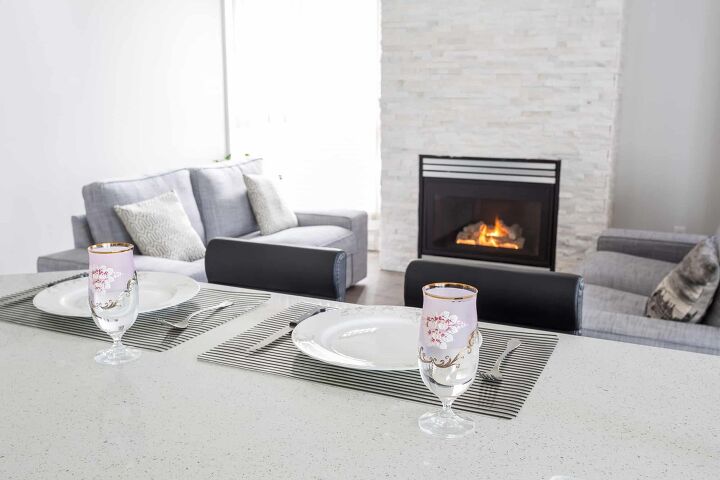Gas Fireplace Goes Out After A Few Minutes? (Possible Causes & Fixes)

Adding a fireplace to your house is a great idea whether you want to raise the aesthetics of the living room or just want to get through those daunting winters with comfort.
If you’ve chosen a gas fireplace, it is also essential that you know how to troubleshoot it properly. For example, if it doesn’t stay on for more than a few minutes at a time, you’ve got a problem at your hands.
If your gas fireplace goes out after a few minutes, check to see that the pilot light is functioning. You can blow some compressed air in the pilot light using a straw, and also ensure that there is no disruption in the airflow. Also, check the thermopile and thermocouple to see if they’re damaged.
But if the problem persists, no need to panic. Read on to find out why your gas fireplace goes out after a few minutes, and how you can resolve the issue for good.
Do You Need Brick or Stone Fireplace Repair?
Get free, zero-commitment quotes from pro contractors near you.

Possible Reasons For A Malfunctioning Gas Fireplace
Gas fireplaces have a variety of components that work simultaneously to produce heat. Here is a rundown of what each part does and how it can contribute to your problem:
The Pilot
To fire up the fireplace, start the pilot light and hold the position for a few seconds and then twist the dial to the “ON” position, and you are good to go.
Now you’ll see two flames – one reaches the thermocouple and the other on the burner.
If the pilot is dust-ridden and requires a cleanup, the fire will lack intensity. This, in turn, won’t light the burner properly, and the second flame will not be able to get close enough to the thermocouple to warm it up. This is when the gas valve’s safety switch kicks in and shuts it off.
Remember, the fire created by the pilot should have a dark blue outline and be sky blue in the center. If you see some shades of yellow, that’s not right. That just means that the flame isn’t hot enough to heat the thermocouple’s tip.
The Thermocouple And Thermopile
The thermocouple features two metal wires that are connected at one end. As for the other ends – they are connected to a thermometer or a thermocouple-capable device.
If the variance between temperatures is inconsistent because of a compromised pilot flame, the thermocouple won’t allow the gas valve to open up and ignite the burner ports. Also, the problem may exist in the thermopile, which is supposed to open the gas valve when the fireplace is ignited.
Both these components perform similar functions, i.e., converting heat to current, but out of the two, the thermopile generates more electricity.
The Oxypilot
The Oxypilot is a built-in safety switch that monitors the indoor environment. It switches off the flame if the air quality gets tainted by carbon monoxide, and the oxygen levels fall considerably.
Simply put, the flame becomes ineffective in the absence of adequate oxygen. This results in inadequate heat levels near the thermocouple, which in turn shuts of the gas valve. The same scenario will occur when the Oxypilot is covered in dust and grim.
How To Fix A Malfunctioning Gas Fireplace
Before you begin, make sure you have the following tools in easy access:
- Digital multimeter
- Stainless Steel Brush
- Fine-grit sandpaper
Step 1: Inspect The Thermopile And Thermocouple Current
Use a multimeter to see if the electricity by the thermopile and thermocouple is at acceptable levels. Follow these steps to run your test:
- Run the pilot light for a few minutes
- Turn off the fireplace
- Locate the thermopile sensor on the control valve and then find contacts marked as TH/TP and TP
- Put the leads of the multimeter on these contacts
- A 300 millivolt reading or more means you are in the clear and that your equipment is in perfect working order
- A reading of less than 300 millivolt means that you should replace the thermopile ASAP
- Now locate the thermocouple sensor and follow the same steps from 1 to 4
- If you get a reading of 25 millivolts or more, then your thermocouple is in good condition; anything less and you may need to replace it.
Step 2: Cleaning Thermopile And Thermocouple
Considering their operation, it is quite common for the thermopile and thermocouple to develop carbon buildups over time. These deposits can hamper their functioning.
However, it’s possible to get them back to their prime working condition with a thorough cleaning. You’ll need sandpaper and a steel brush to do it. Simply wipe away the soot and deposit.
Step 3: Run A Test
Once you are satisfied with the cleanup, light up the pilot. Keep it on for a few minutes, and then check the electricity status via the multimeter. If the readings are now acceptable, your job is done. But in case you still get abysmal results, it’s time to move on to the next step.
Step 4: Replacements
In case the thermocouple and thermopile look too far gone, you’ll have to replace them. But don’t worry; these components are easy to install and aren’t expensive at all, so you DIY this step.
Just make sure you get the right make and model before you add them to the fireplace.
This should ideally help fix a fireplace that won’t stay lit. But in case you are still facing issues, here’s another in-depth article to help you figure out how to troubleshoot a gas fireplace that keeps going out.
Also, quickly check out the following possible causes of trouble:
Some Other Reasons Your Gas Fireplace Keeps Going Out
Apart from issues with the integral components, here are some other reasons why your gas-powered fireplace won’t start:
- Batteries — If your fireplace comes with a receiver or a remote control that operates it, chances are that the batteries on it may be drained. So replace them fast.
- Tripped Breaker—If the demand for current increases and the circuit breaker cannot handle it, the breakers will trip to protect the circuit board from being damaged. Check it and put it back in its original position.
- Gas Valve — The gas valve should always be in the open or ON position for an adequate flow of gas. You’ll find it in the firebox; check to make sure that it’s on.
- Propane Tank—if you use a tank, make sure that it’s filled.
Still, if the problem persists, you may need to call in an expert. In fact, it is a good idea to leave fireplace repairs to a professional if:
- You use natural gas, and facing problems receiving the right amount of pressure
- You have a faulty gas valve
- There is moisture in the gas pipeline
- The burner is visibly dirty and clogged
Do You Need Brick or Stone Fireplace Repair?
Get free, zero-commitment quotes from pro contractors near you.

Related Questions
How Often Do You Have To Replace Gas Fireplace Logs?
These logs are fireproof, and they stay strong despite the heat. But it’d a good idea to replace them after prolonged usage of several years, even if they look fine.Depending on how much your fireplace is used, you should replace the logs, aka embers, after every three to five years.
Is It Dangerous To Leave A Gas Fireplace On?
It would be best if you had proper ventilation in the area these fireplaces are installed, as all created fumes need to be driven outside your house.Considering the potential dangers, such as gas spreads and fire hazards, these fireplaces should not run for more than two to three hours at a stretch.Find out if it’s ok to leave a gas fireplace on overnight.
How Much Does It Cost To Fix A Gas Fireplace?
If the fixes mentioned here did not help you out, then there is no choice but to call in an expert. Depending on the damage, be ready to pay anywhere between a $90 to more than $295 to get your fireplace back in working condition.

Ian Haynes is a digital marketing specialist and has successfully written hundreds of home improvement guides. Outside of his work, Ian likes fixing old bikes and exploring Brooklyn with his Labrador.
More by Ian Haynes



























